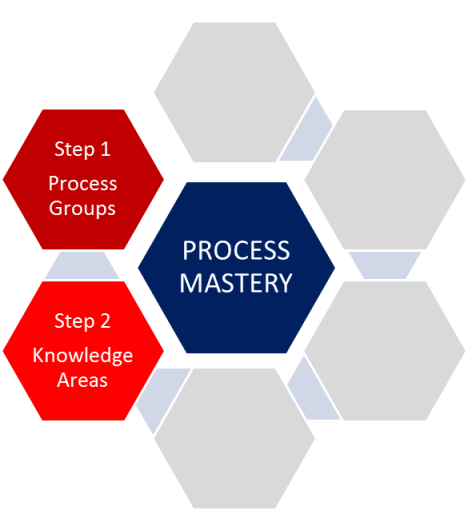The first two steps you need to in order to memorize the 42 processes of project management is to be aware of which process group and knowledge area they belong to.

Step 1: Memorizing the Process Groups
The process groups are:
- Initiating
- Planning
- Executing
- Monitoring & Controlling
- Closing
In class we learned cute mnemonic devices such as “In Projects, Every Monkey Counts Coconuts” to memorize the order, but in our study group, we wanted to go beyond such short-term memory tricks in order to gain a real understanding of WHY these are in the order they are in.
Of course, the Plan-Do-Check-Act cycle people are familiar with can be transferred to understanding the order of process groups 2, 3, and 4, like so:

Then process groups 1 and 5 are the “book ends” to this iterative cycle, and the sequence is now complete.
Step 2: Memorizing the Knowledge Areas
There are 9 knowledge areas, and these correspond to chapters 4 through 12 in the PMBOK® Guide. These are:
Chapter 4. Project Integration Management
Chapter 5. Project Scope Management
Chapter 6. Project Time Management
Chapter 7. Project Cost Management
Chapter 8. Project Quality Management
Chapter 9. Project Human Resources Management
Chapter 10. Project Communications Management
Chapter 11. Project Risk Management
Chapter 12. Project Procurement Management
The first one, integration, goes first because it integrates all of the other management areas from scope through procurement that come in later chapters.
The next four are actually part of the “iron triangle of constraints”, the original form of the concept of constraints as formulated by Dr. Martin Barnes in 1969.

If you think of the “scope” as one of the first things you describe in a “scope statement” and then detail in the “scope management plan”, then that makes sense that it is next (after integration).
Then time, cost, and quality are the natural successors to this according to the triangle if you go clockwise around the diagram above. (Dr. Martin Barnes had “output” as a key constraint, which to him was a combination of “scope” and “quality”.)
So, next after scope, time, cost, and quality, you have to have somebody to do the work, and then a means for them to talk to one another. So that gives you the next two, “human resources”, and “communications”. And why do you want to communicate? What if something goes wrong? There’s always a risk of that, so that’s why “risk” is the next one in the list.
And finally, you had to have “equipment” to do the work, and that gives you the final area.
If you stick to a logical framework that puts the 9 chapters together in a narrative like this, you will find yourself being able to memorize the knowledge areas without too much trouble in a way that makes logical sense rather than relying on the caprices of short-term memory.
Tomorrow, we put these 5 process groups and 9 knowledge areas together, and we draw: THE MATRIX!
Filed under: Uncategorized |


Leave a comment